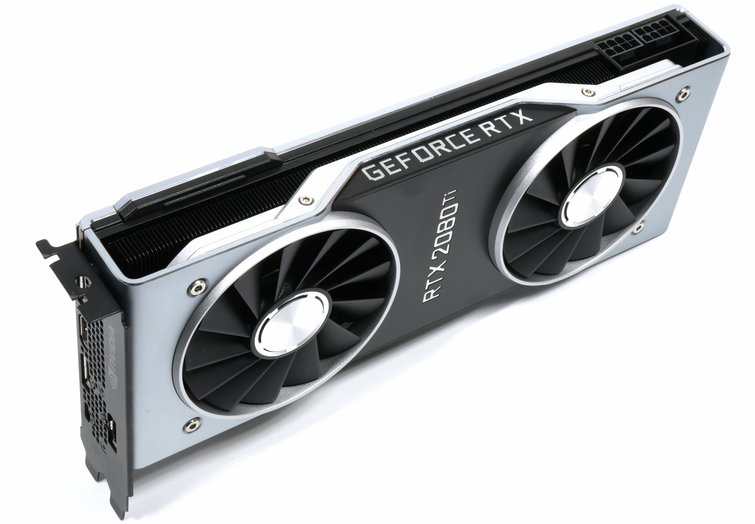
1 – GeForce RTX 20 Series Overview
NVIDIA has officially launched the new GeForce RTX 20 Series graphics cards today based on the Turing GPU architecture. For this launch day, two graphics cards are available: the GeForce RTX 2080 Ti and the GeForce RTX 2080.
The GeForce RTX 2080 Ti is based on cut-down version of a full TU102 GPU. A full TU102 includes 72 SMs, 4608 CUDA cores, 576 tensor cores, 72 RT cores, 288 TMUs and 96 ROPs. The RTX 2080 Ti comes with a TU102 GPU where four SMs have been disabled. A Turing SM (streaming multiprocessor) packs 64 CUDA cores, 8 tensor cores and one RT cores (Ray Tracing).
The GeForce RTX 2080 is based on another Turing variant, the TU104 that has 2944 CUDA cores, 368 tensor cores and 46 RT cores.
Both graphics cards comes with all new features such as:
- hardware ray tracing capabilities (RT cores), tensor cores (specialized execution units designed specifically for performing the tensor / matrix operations that are the core compute function used in Deep Learning)
- mesh shading (which advances NVIDIA’s geometry processing architecture by offering a new shader model for the vertex, tessellation, and geometry shading stages of the graphics pipeline, supporting more flexible and efficient approaches for computation of geometry)
- variable rate shading or VRS that allows developers to control shading rate dynamically, shading as little as once per sixteen pixels or as often as eight times per pixel
- DLSS or Deep-Learning Super-Sampling which is a new antialiasing technique based on built-in deep-neural networks (DNN) that are accelerated by tensor cores!
- GDDR6 graphics memory
- second-generation NVLink to connect two GeForce RTX
The RTX 2080 Ti is more or less 30 % faster than the previous GTX 1080 Ti. The RTX 2080 is 10 % faster than the previous GTX 1080 and 30% slower than the RTX 2080 Ti.
2 – GeForce RTX 2080 Ti Reference and FE Specifications
- GPU: TU102 (Turing), 12nm TSMC, 18.6 billion transistors, base clock: 1350MHz, boost clock: 1635MHz (FE) or 1545MHz (reference)
- SMs: 68
- CUDA cores: 4352
- Tensor cores: 544
- RT cores (Ray Tracing): 68
- Texture units (TMUs): 272
- Raster Ops units (ROPs): 88
- Memory: 11GB GDDR6, memory interface: 352-bit
- TDP: 250W (reference) / 260W (FE)
- Power connectors: 8-pin + 8-pin
- HDMI 2.0b + DisplayPort 1.4
- Price: $1000 (ref) / $1100 (FE)


3 – GeForce RTX 2080 Reference and FE Specifications
- GPU: TU104 (Turing), 12nm TSMC, 13.6 billion transistors, base clock: 1515MHz, boost clock: 1800MHz (FE) or 1710MHz (reference)
- SMs: 46
- CUDA cores: 2944
- Tensor cores: 368
- RT cores (Ray Tracing): 46
- Texture units (TMUs): 184
- Raster Ops units (ROPs): 64
- Memory: 8GB GDDR6, memory interface: 256-bit
- TDP: 215W (reference) / 225W (FE)
- Power connectors: 8-pin + 6-pin
- Price: $700 (ref) / $800 (FE)

4 – RTX 2080 Ti and RTX 2080 Reviews
- RTX 2080 Ti Founders Edition @ techpowerup.com
- RTX 2080 Founders Edition @ techpowerup.com
- NVIDIA GeForce RTX 2080 and RTX 2080 Ti Review @ pcper.com
- Nvidia GeForce RTX 2080 Ti Founders Edition Review: A Titan V Killer @ tomshardware.com
- Nvidia RTX 2080 and 2080 Ti review: A tale of two very expensive graphics cards @ arstechnica.com
- Nvidia GeForce RTX 2080 review: 4K gaming is here, at a price @ theverge.com
- NVIDIA RTX 2080 and 2080 Ti review: To 4K 60 FPS, and beyond @ engadget.com
- NVIDIA GeForce RTX 2080 Ti And RTX 2080 Benchmarks: Turing Is A Beast @ hothardware.com
https://www.nvidia.com/download/driverResults.aspx/138070/
Nvidia GeForce 411.63 WHQL driver
http://blog.icare3d.org/2018/09/nvidia-turing-vulkanopengl-extensions.html
NVIDIA Turing Vulkan/OpenGL extensions
2080 is basically 1080Ti + RTX, which is what I expected… I like how the reviews basically say – insane price, but 9/10, 4.5/5… Wow, they were not pressured by NVIDIA at all… When the CEO says – the price doesn’t matter any more, you better listen.
we need real and independent reviews and tests…
https://news.developer.nvidia.com/nvidia-announces-nsight-graphics-2018-5/
“NVIDIA is proud to announce Nsight Graphics 2018.5 with Turing GPU support!
This release offers Turing profiling support for Nsight Graphics’ Range Profiler and GPU Trace activities. In addition, copy queue activity can now be visualized in GPU Trace (our new GPU Occupancy Profiler).
Nsight Graphics has day zero support for the new Turing GPU architecture, unlocking the power of the Range Profiler and GPU Trace activities. With the Range Profiler, we provide a tremendous amount of data to allow you to maximize the throughput of your GPU. “
https://developer.nvidia.com/cuda-toolkit/whatsnew
https://developer.nvidia.com/cuda-downloads
“CUDA 10 is the most powerful software development platform for building GPU-accelerated applications. It has been built for Turing GPUs and includes performance optimized libraries, a new asynchronous task-graph programming model, enhanced CUDA & graphics API interoperability, and new developer tools.”
CUDA Toolkit 10.0 released.